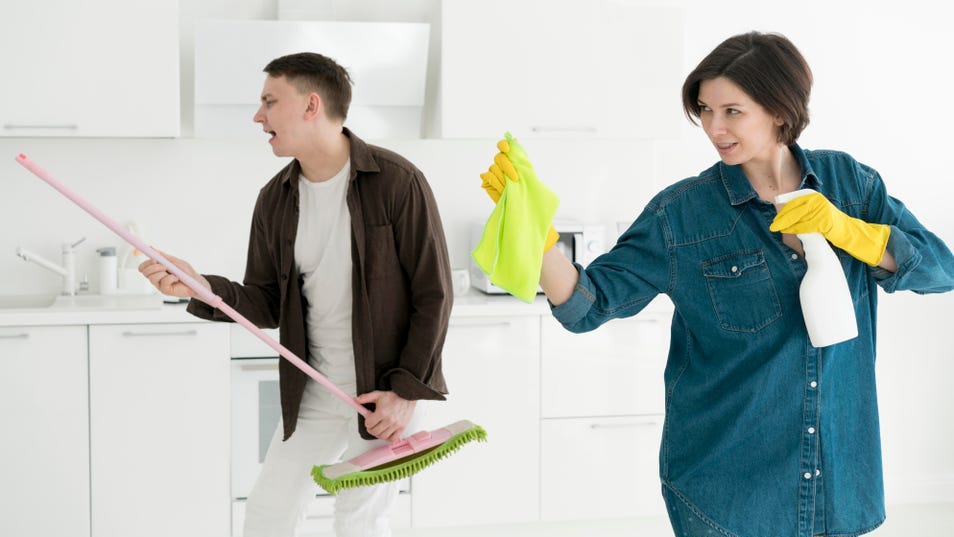Cleaner vs. Disinfectant: What is the difference between them

The key distinction between cleaner vs. disinfectant lies in their respective functions.
A cleaner is designed to remove dirt, debris, and germs from surfaces, primarily focusing on the visual aspect.
On the other hand, a disinfectant is formulated to kill or neutralize a broader spectrum of harmful microorganisms, such as bacteria, viruses, and fungi, making the treated surface safer from potential infections.
Let’s find how the two are different from each other and their appropriate usage.
What is the Difference Between Cleaning and Disinfecting?
The main cleaning objectives are to remove dirt, dust, grime, and visible dust from surfaces, enhance appearance and promote a pleasant environment.
Disinfecting aims to remove or reduce the presence of harmful microorganisms, such as bacteria and viruses, contributing to a healthier space by decreasing the risk of infections.
The main difference between cleaning and disinfecting is that cleaners enhance the cleanliness and appearance of surfaces and disinfectants aid in the reduction of disease-causing agents to promote a healthier environment.
When to Use Cleaners
Cleaners should be used to maintain cleanliness and hygiene whenever surfaces collect dirt, stains, or grime through regular use or exposure.
These products are particularly effective for routine cleaning tasks, such as wiping down countertops, cleaning bathroom toilet and kitchen fixtures, and maintaining the cleanliness of floors.
Using cleaners can efficiently remove visible contaminants, keeping your living and working spaces visually appealing and hygienic.
Use all-purpose cleaners or sprays for regular cleaning tasks to effectively remove everyday dirt, grease, and grime from surfaces
To ensure safe and efficient cleaning, follow these tips:
1) Ventilation
Ensure proper ventilation while cleaning to avoid inhaling harmful fumes and improve air circulation.
2) Read The Instructions
Always read and follow the instructions on cleaning product labels to use them correctly, safely, and to avoid wasting the product and ensure effectiveness.
3) Storage
Store cleaning products away from children and pets in their original containers.
When to Use Disinfectants
Disinfectants can be used to kill or neutralize harmful microorganisms on surfaces, particularly in areas with a higher risk of germ transmission.
Use antibacterial or sanitizing disinfectants during illness outbreaks or when dealing with known contaminants.
Prioritize disinfecting high-touch surfaces like doorknobs, light switches, and shared electronic devices to maintain a hygienic environment and reduce the spread of infections.You’ll need to use a bathroom disinfectant to get rid of the pesky pathogens that hide in your bathrooms as this area might collect germs more frequently than other spaces.
Remember to follow product instructions and safety guidelines to ensure effective and safe disinfection. Consider the following tips:
High Touch Areas
Identify the high touch areas and then focus on disinfecting those surfaces.
Contact Time
Allow disinfectants to remain on surfaces for the recommended contact time, as indicated on the product label, before wiping or rinsing.
Applicators
Use disposable wipes or clean cloths for application, and avoid cross-contamination by using separate tools for different areas.
Protective Equipment
Wear appropriate personal protective equipment such as gloves and masks to minimize contact with disinfectants.
Cleaner vs. Disinfectant: Making the Right Choice
Choosing between a cleaner and a disinfectant involves understanding their specific purposes.
Disinfectants are crucial for targeting harmful microorganisms in high-touch areas whereas cleaners are good for getting rid of visible dirt and grim
To strike the right balance, incorporate cleaners and disinfectants into your cleaning routine for a well-maintained and hygienic environment.
To sum it up, cleaners focus on aesthetics; disinfectants prioritize health protection. Both play vital roles in maintaining a safe and tidy space, and their combined use ensures comprehensive cleaning and sanitization.
FAQs
Can I use a cleaner as a disinfectant or vice versa?
While a cleaner can remove dirt and grime, it might not effectively kill harmful microorganisms like a disinfectant. However, some disinfectants can also clean to some extent. It's best to use each product as intended for optimal results.
Which is more effective in killing bacteria and germs: a cleaner or a disinfectant?
A disinfectant is specifically formulated to be more effective in killing bacteria and germs compared to a cleaner, which primarily focuses on removing visible dirt and grime.
Are there any potential risks or drawbacks associated with using cleaners or disinfectants?
Yes, using cleaners and disinfectants can come with potential risks and drawbacks. Over-reliance on harsh chemicals or improper usage might lead to skin irritation or respiratory issues. Incorrect mixing of products can produce harmful fumes.
Excessive use may damage surfaces. Disinfectant-resistant germs could develop over time. Proper usage, ventilation, protective measures, and adherence to guidelines are essential to minimize these risks and ensure safe and effective cleaning and disinfection.
Can a cleaner effectively eliminate bacteria and viruses, or is disinfectant necessary?
While a cleaner can remove dirt and some bacteria from surfaces, a disinfectant is necessary to effectively eliminate a broader range of bacteria and viruses. Disinfectants are specifically formulated to target and kill harmful microorganisms, providing a higher level of sanitization and reducing the risk of infections
.png?width=70&height=88&format=png&quality=50)